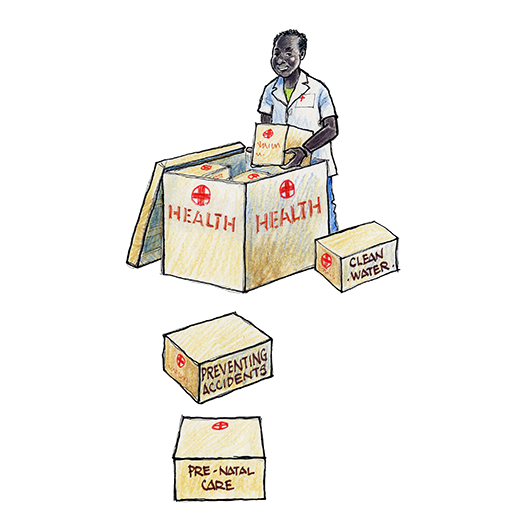3.4 Unpacking Article 24, the right to health

Article 24 of the UN Convention does not establish an unconditional right to be healthy. However, it does specify a range of measures needed to fulfil the right to health. The obligations in Article 24, and the challenges in meeting them, include the following:
- To diminish infant and child mortality (Article 24(2a))
This Article imposes obligations on governments to take appropriate measures and implement policies to reduce mortality rates throughout childhood. Traditionally, the emphasis has been on tackling deaths among children under five years of age. The continuing death of millions of children each year from preventable causes remains unacceptably high. A child born in a developing country is over 13 times more likely to die within the first five years of life than a child born in an industrialised country. In sub-Saharan Africa, on average, one child in every six dies before their fifth birthday (Closing the Gap in a Generation: Health Equity through Action on the Social Determinants of Health, WHO/Commission on the Social Determinants of Health, 2008).
By contrast, if the infant mortality rate in Iceland was applied to the whole world, only two babies would die in every 1000 born alive (World Health Organization (WHO) (2007c) World Health Statistics 2007, Geneva, WHO). There would be 6.6 million fewer infant deaths in the world each year. However, in a growing number of countries, it is adolescents who are particularly at risk, with 1.4 million deaths occurring among 10- to 19-year-olds every year (World Health Organization (2009) Child and Adolescent Health and Development Progress Report: Highlights, p. 16).
- To ensure the provision of necessary medical assistance and health care to all children with emphasis on the development of primary health care (Article 24(2b))
The UN Convention requires governments to invest in the provision of health care services, including mental health services, to address the health care needs of all children. However, according to the World Health Organization, in 12 out of 32 countries in Africa less than 50 per cent of people have access to health care services. In particular, in many countries there is a lack of available mental health services for children. This is despite very high levels of need, particularly in countries where there is or has been conflict or instability.
- To combat disease and malnutrition (Article 24(2c))
A large number of children in poorer communities die before the age of five due to a combination of communicable diseases, malnutrition, unsafe water and sanitation. Some risks can be reduced through immunisation, which therefore ought to be made available to all young children.
Oral rehydration therapy can save lives in the case of diarrhoea. It should be provided by health facilities or parents should be given advice about how they can administer rehydration at home through simple technology. The most fundamental problem is malnutrition, which globally is the cause of one-third of all deaths of children under five.
- To provide pre and post-natal care for mothers (Article 14(2d))
Maternal mortality and morbidity constitute grave violations of the human rights of women and girls. It poses serious threats to children’s rights to life, survival and development. Thirty-seven per cent of deaths of children under the age of five occur in the first month of life. Improved neonatal and maternal care could save many newborns. Two-thirds of both neonatal and young child deaths – over 6 million deaths every year – are preventable.
- To provide knowledge of child health and nutrition, breastfeeding, hygiene and prevention of accidents (Article 24(2e))
Despite being the cheapest and healthiest way to feed a baby, more than one million babies worldwide die every year because they are not breastfed or are given other foods too early (UNICEF, 2012). Millions more live in poor health, contract preventable diseases and battle malnutrition. Globally, only 35 per cent of children under four months are exclusively breastfed (World Health Organization, n.d.).
- To develop preventive health care, guidance for parents and family planning education and services (Article 24(2f))
Prevention is central to primary health care. Interventions should promote healthy behaviour. They should address the main health challenges facing children within the community and the country as a whole. These challenges include diseases as well as accidents, violence, substance abuse and mental health problems. Access to parenting information and reproductive health services are vital to improving the health of women and children.
- To abolish traditional practices prejudicial to the health of children (Article 24(2g))
Many traditional practices are harmful to children’s health and development. The Committee on the Rights of the Child have made it clear that practices such as female genital mutilation are a violation of the right to health, and that efforts need to be made to prohibit them through legislation and community sensitisation.
Think about your own country. Can you identify any initiatives that have been made to address these challenges?
If you have access to the internet you can look up your government’s official report to the United Nations. To do this:
- Go to the United Nations website at: http://tbinternet.ohchr.org/ _layouts/ treatybodyexternal/ TBSearch.aspx?Lang=en
- Under the heading ‘Filter by State’, tick the box next to your country.
- Under the heading ‘Filter by Committee’, tick the box next to where it says ‘CRC’.
- Under the heading ‘Filter by document type’, tick the box next to where it says ‘reports’.
- You will see that the reports from the governments are called State Party’s Report.
You may need to scroll up and down to find the right boxes to tick.
3.3 Defining the right to health
